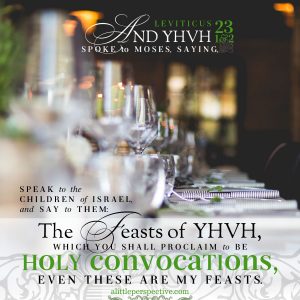The seven annual feast days are holy days, which God has set apart from the rest of the days of the year, as feast days for Himself:
“And the LORD spoke to Moses, saying, “Speak to the children of Israel, and say to them: ‘The feasts of the LORD, which you shall proclaim to be holy convocations, these are My feasts.” Lev 23:1-2
“Feasts” in Hebrew, is moed, Strong’s H4150, mem vav ayin dalet, which means, an appointed place or time of meeting. Now this word is interesting. Its first occurrence in Scripture is in the very first chapter of Genesis, during Creation Week:
“Then God said, “Let there be lights in the firmament of the heavens to divide the day from the night; and let them be for signs and seasons [moed], and for days and years;” Gen 1:14
In this passage it has the meaning of an appointed time. This is why the new moon is marked throughout the year, so that we will know which day of the month it is, for God marks the days of the month from one new moon to the next. And when the season of spring has arrived, the celebration of the annual feasts begins with Passover, on the 14th day of the first month, or 14 days after the new moon appeared when the barley is in its head.
Another common occurrence of moed in Scripture is found in Torah:
“Moses took his tent and pitched it outside the camp, far from the camp, and called it the tabernacle of meeting [moed]. And it came to pass that everyone who sought the LORD went out to the tabernacle of meeting which was outside the camp.” Exo 33:7
In this passage and in others like is in which is the phrase, tabernacle of meeting or tent of meeting, moed has the meaning of an appointed place. So the moed, the feast days of the Lord, are those set apart or separated (the meaning of the word “holy”) days in which the Lord has made an appointment. To do what? Ah, that is the mystery that both history and Scripture unfolds!
Now it just so happens, that if we write out a table of the moed or feast days of the Lord, we find an interesting pattern revealed (the listing of the annual feast days are from Lev 23):
—– the spring feasts —–
1A Passover precedes
1B week long feast of Unleavened Bread
1C Firstfruits, when Jesus rose from the dead, the firstfruits of the resurrection (1 Cor 15:20-23)
—– the central feast by itself —–
–> X Weeks (Pentecost), on which the Torah and the Spirit was given (Exo 19-20, Act 2)
—– the fall feasts —–
2C Trumpets, when will be the resurrection of those who are His at His coming (1 Cor 15:52, 1 The 4:16)
2B week long feast of Tabernacles
2A 8th Day of Assembly follows
The cycle of annual feasts not only forms a chiastic structure, but if the table was rotated counterclockwise 90 degrees and the As, Bs, and Cs matched with drawn lines, you would have an exact representation of a menorah (Broken link, active November 22, 2009)! The menorah is the seven branched candelabrum, which was to be kept lit continually in the Temple, in the Holy Place. Light in Scripture is often representative of truth, or witness! Jesus said that He is the Light of the World (Joh 8:12), and we are to be lights of the world, by shining forth like a city set on a hill, which can be seen from a distance (Mat 5:14)! How exactly do we shine forth? Our lives bear witness of something, and that witness is like a light!
So since the annual feast days are pictured by the menorah, we can conclude that each day shines a light, that bears witness to something. And we see that this is true.
The feast day of Passover, when we celebrate it, bears witness to the Passover Lamb, who was crucified on this day, and shed His blood for our sins, that the angel of death might pass over us.
The feast day of Unleavened Bread, when we celebrate it, bears witness to the Holy and Righteous God to whom we now belong. For now that we have been forgiven of sins, we cleanse our lives of sin, which yeast represents, and keep our lives free of sin.
The feast day of Firstfruits, when we celebrate it, bears witness to the resurrection from the dead of Jesus our Messiah, who was raised from the dead with new life on this day.
The feast day of Weeks, or Pentecost, when we celebrate it, bears witness that the Torah – God’s Word – and the Spirit are one, and that we need the Spirit in order to walk in Torah, and that we need the Torah in order to walk in the Spirit! And that, by the Torah and the Spirit, we are to walk as we await the coming of Jesus our Bridegroom!
The feast day of Trumpets, when we celebrate it, proclaims prophetically that Jesus is returning again, and that we will likewise be raised from the dead as He was, at His coming!
The feast day of Tabernacles, when we celebrate it, proclaims prophetically that Jesus is returning as a Bridegroom for His Bride – who is us! – and that at His return, He will dwell with us and we with Him!
The feast day of the 8th Day of Assembly, when we celebrate it, proclaims prophetically that we will spend eternity with YHVH, beyond time and space!

















Leave a Reply